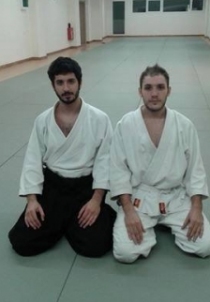"BACK" IN THE GYM!
A Hypertrophy Guide To Training Your Back! (Muscle Gain)
WHY SHOULD YOU TRAIN YOUR BACK?
The real question is, why wouldn’t you train your back?
Believe it or not, quite a few people ignore back training or simply don’t dedicate their max efforts to it. Some of the most common excuses I have found are:
“It’s behind me so I can’t see it anyways.”
“I’m just interested in chest and arms.”
“My back hurts so I shouldn’t train it.”
Just for the record, let’s take a closer look at these “excuses” as I dispute them for those of you who may be in agreement with them.
- It is behind me so I cannot see it…
- Others can! Short and simple.
- Others can! Short and simple.
- I am just interested in chest and arms…
- You will never have a big chest or big arms without a big thick strong back! Why is that? The answer is because your back is the foundation to all your upper body lifts. Your legs & core play a big role as well, but that’s an entirely different article. Without a strong back, it would be very difficult for you to continue to grow muscle when benching, shoulder pressing and even performing exercises like bicep curls. The reason is because the alignment of your spine plays a crucial role to all of those lifts and is why “thoracic extension” is so important. Thoracic extension is quite simply when you arch your back and pull your shoulder blades down and together thus sticking your chest out. Most people cannot do this or do not possess the muscle control to be able to do this, resulting in poor results in most compound lifts like the ones mentioned above.
- You will never have a big chest or big arms without a big thick strong back! Why is that? The answer is because your back is the foundation to all your upper body lifts. Your legs & core play a big role as well, but that’s an entirely different article. Without a strong back, it would be very difficult for you to continue to grow muscle when benching, shoulder pressing and even performing exercises like bicep curls. The reason is because the alignment of your spine plays a crucial role to all of those lifts and is why “thoracic extension” is so important. Thoracic extension is quite simply when you arch your back and pull your shoulder blades down and together thus sticking your chest out. Most people cannot do this or do not possess the muscle control to be able to do this, resulting in poor results in most compound lifts like the ones mentioned above.
- My back hurts so I shouldn’t train it…
- The reason your back hurts could very well be BECAUSE you’re not training it, which would result in overtraining your push-pattern (pressing) exercises and not balancing them out with the pull-pattern exercises. Also keep in mind that if your back is weak, you may develop postural problems in the future as your spine will not have the needed support to stay straight/aligned.
BASIC BACK ANATOMY:
Your back is divided into many muscle groups. I do not wish to make things too complicated so I will just mention the larger muscle groups.
- Lats (IMAGE 1)
The lats are those huge muscles located underneath your armpit. They are actually the longest muscles in your body, starting from your shoulder and extending all the way down to your lower back. They are your “wings”.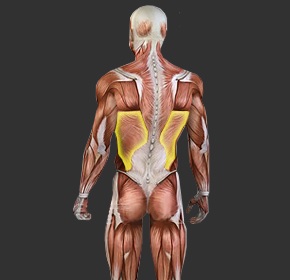
- Traps (IMAGE 2)
People seem to think only the muscles to the sides of their neck are their traps but, in actuality, the traps extend down to your mid back. The part of the muscle at the sides of the neck is just the upper trapezius but there are also the mid trapezius and lower trapezius.
- Rhomboids (IMAGE 3)
You cannot see the rhomboids. They are located underneath your traps at the mid back area. However, they play a key role in the thickness of your back.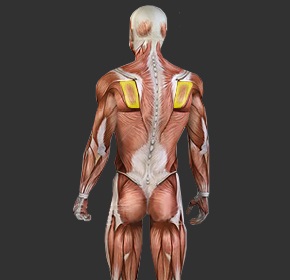
- Lower Back (IMAGE 4)
The muscle groups in the lower back include stabilizers and spinal support muscles. They surround your lower back and help provide stability to your core.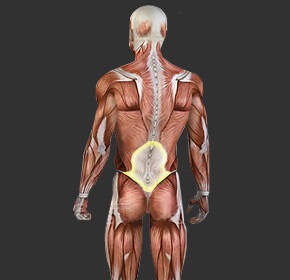
- Rear Delts (IMAGE 5)
Yes, they are a part of your back thickness and are very important for shoulder health.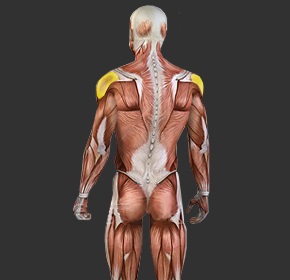
BEST BACK EXERCISES FOR HYPERTROPHY
There are many back exercises to choose from. I would like to take a minute and discuss my personal favorites, why they are my favorites, which muscles they target and how to perform them with proper form.
- Shoulder-Width Grip Overhand Pull-Up (VIDEO 1)
The pull-up is possibly the best back exercise you can perform. They focus mainly on your upper lats as well as rhomboids, rear delts and lower traps. Your biceps and forearms work as secondary muscles in the exercise, especially as you begin to add weight to your bodyweight.
- Barbell Row (VIDEO 2)
You can do these with either an overhand or underhand grip. The overhand grip will target more of your upper back (upper lats, rhomboids, the whole trapezius, rear delts). Underhand grip will focus more on the lower lats, biceps and lower trapezius. Be sure to alternate between these two grips, either by set or training session. Maybe even superset them together. They will help give you the back thickness you desire.
- T-Bar Row (My all-time favorite) (VIDEO 3)
The T-bar row is an excellent exercise for targeting your lower lats so that your wings look huge not only from the back, but from the front as well. They target your rhomboids and traps in a unique way and also utilize your lower back stabilizers to hold your upper body in place throughout the exercise. One of my favorite methods to incorporate this exercise into my workout is with drops sets. Start by using only 25lb plates (as many as you can), and remove one plate for each drop until you strip the bar of 25s. Your back will be screaming! The use of 25lb plates is preferred over the 45s because they provide a bigger range of motion.
- Neutral Grip Lat Pulldown (Palms Facing In) (VIDEO 4)
The best way to hit your lats is to fully shorten and stretch them. This exercise enables you to do that since you can bring your wrists all the way down to your chest thus driving your elbows down as far as possible. I would say that this is the ultimate lat exercise for width. If your gym does not have a parallel grip bar attachment you can do the underhand grip variation instead.
- Face Pull (VIDEO 5)
Believe it or not, many gym goers avoid this exercises. I believe it’s because most people fail to perform it with proper form and are unable to realize the true potential of the movement. Face pulls will not only balance your push/pull pattern we talked about earlier, but will also fire up your upper back muscles like no other exercise ever will. This exercise is amazing for rear delts as well which will in time give you that “mountains and valleys” look in your back.
Although most of these exercises will stimulate your lower back, as it stabilizes the lifts, you should also choose an exercise to target it more efficiently. Deadlifts and superman hyperextension are great choices.
Try both and stick with what suits you better, I will prove links below.
HOW TO TRAIN YOUR BACK FOR HYPERTROPHY
The best way to achieve hypertrophy to any muscle group with HIGH VOLUME and a PROGRESSIVE OVERLOAD. That means a lot of sets and reps, but how many? You want to complete enough sets and reps to ensure that you are making progress each week. No more than that. More is not always better.
The back is not like the arms or legs or shoulders. It’s easy to just lift weights for those parts and expect them to grow, because the tension travels almost directly into those muscles. But the story is different with your back and chest. You have to make sure you are stretching the muscle as much as possible and you are contracting it as much as possible. That means two things. First, go through a full range of motion (ROM) with every exercise. This way you ensure that you are stimulating as much muscle fiber as possible. Secondly, whatever back exercise you choose, make sure you are maintaining a thoracic extension. This is the only way to fully shorten (contract) your back muscles (and to prevent spinal injuries).
Lastly, when performing compound lifts, such as all of the above, make sure you are keeping your entire body tight. That means tight abs, tight back, tight quads and tight glutes. Flexing those muscles while you perform your back exercises will help prevent “energy leaks” from your body. You can also move more weight if you are standing on a stable platform. This way all your energy will be moved into the muscle you are trying to work. Look at it like this: when performing a pull-up, most people complain they cannot do more than 4 - 5 or even less. One of the reasons why is they are carrying “dead weight”. That means their feet are dangling, their whole lower body is shaking and moving back and forth. Try contracting all your lower body muscles next time you perform the pullups, keeping your body stiff. I guarantee that you will push out extra repetitions!
CONCLUSION
Now, I could go on and tell you how many reps, how many sets, how much weight, how much rest intervals between sets. But I will not. What you have to understand is that bodybuilding is not only science. It is an art. You have to become one with your body. You have to build your mind-muscle connections. Everybody can flex their bicep. You probably can too. But almost nobody seems to be able to flex their rhomboids or their lats. Keep practicing that between sets. We are natural bodybuilders. Don’t try to mimic those people that are moving extremely high weights and think that you should do that too.
The key to any muscle hypertrophy and especially back hypertrophy is a mixture of:
- Time Under Tension (TUT)
- Hitting the muscle from different angles
- Small rest intervals
- Moderate weight, lots of repetitions
- Sleep, recovery and nutrition
- Mental concentration, patience and love for what you are doing
Common mistakes would be the following:
- Not arching your back
- Round of the lower back (flexion)
- Not maintaining proper form throughout the whole exercise
- Going way too fast on the repetitions
- Taking too much of a break between sets
- Not doing enough rowing exercises
- Not using the back muscles when performing back exercises (example: momentum)
There you go! I hope this article helps and inspires a lot of people. So go in the gym and do some back! Have fun with it. It’s a fun muscle group! But then again...which muscle group isn’t? #HermanitesTrainHarder






